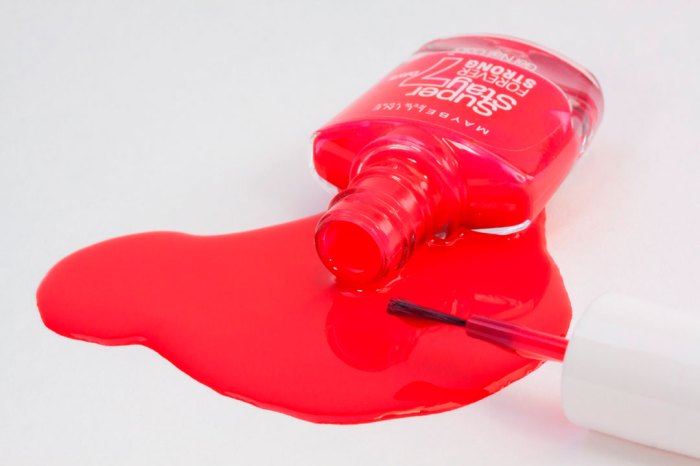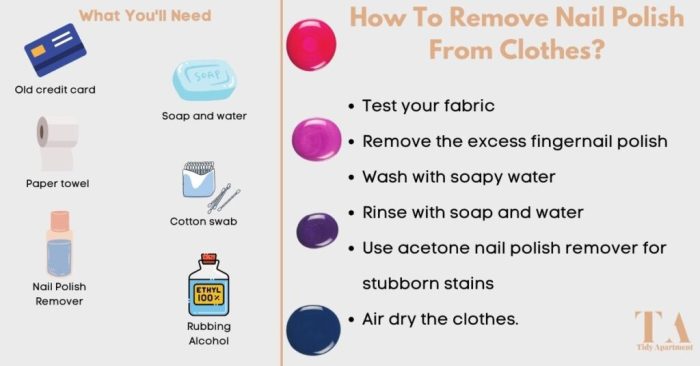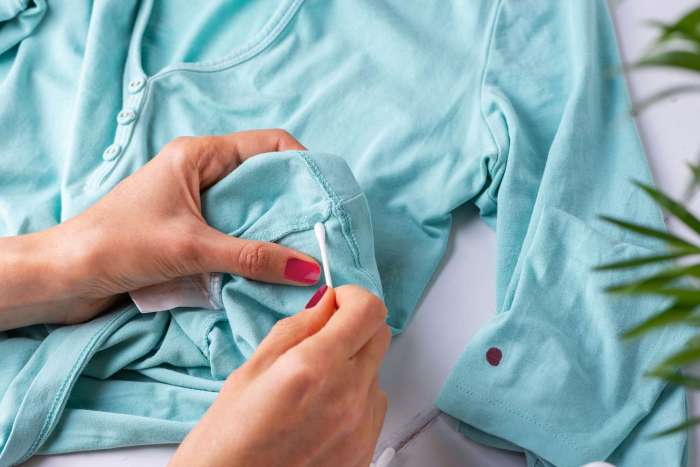How to Get Dried Nail Polish Out of Clothes
Removing Dried Nail Polish from Clothes: How To Get Dried Nail Polish Out Of Clothes
How to get dried nail polish out of clothes – Accidents happen. A stray drop of nail polish can quickly ruin a favorite shirt or dress. This guide provides a comprehensive approach to removing dried nail polish from various fabrics, offering both solvent and non-solvent methods, along with crucial pre- and post-treatment steps. Remember, always test any cleaning solution on an inconspicuous area first to avoid damaging the fabric.
Understanding Dried Nail Polish on Fabric
Nail polish, composed primarily of film-forming polymers, plasticizers, and solvents, adheres differently to various fabrics. Natural fibers like cotton and linen are generally more porous, allowing the polish to penetrate deeper, making removal more challenging. Synthetic fabrics like polyester or nylon, being less porous, may show surface staining that’s easier to lift. The age of the stain significantly impacts removal; fresh stains are easier to tackle than those that have had time to set.
The type of nail polish itself matters too – glitter polishes, for instance, present a greater challenge due to their embedded particles.
Pre-Treatment Methods

Source: housecleaningadvice.com
Before attempting any removal, proper preparation is key. First, identify the stain’s age. Fresh stains are much more amenable to treatment. Gently scrape away any excess dried polish using a dull knife or spoon. Then, carefully blot (don’t rub!) the stain with a clean cloth to lift as much polish as possible.
Finally, and crucially, test your chosen cleaning solution on an inconspicuous area of the garment – an inside seam, for example – to ensure it doesn’t damage the fabric or cause discoloration.
Removal Methods: Solvents
Several solvents can effectively remove nail polish, each with its pros and cons. Acetone is a potent solvent, but it can also damage certain fabrics. Nail polish remover, often containing acetone, is readily available but its strength varies. Rubbing alcohol is a gentler alternative, while hydrogen peroxide is a less aggressive option, suitable for delicate fabrics. Always ensure adequate ventilation when using solvents and wear gloves to protect your skin.
| Solvent | Effectiveness | Fabric Suitability | Safety Precautions |
|---|---|---|---|
| Acetone | High (especially for fresh stains) | Suitable for sturdy fabrics (cotton, linen); avoid on delicate fabrics (silk, wool) | Well-ventilated area, gloves |
| Nail Polish Remover (Acetone-based) | Moderate to High | Test on inconspicuous area first | Well-ventilated area, gloves |
| Rubbing Alcohol | Moderate (best for fresh stains) | Generally safe for most fabrics | Well-ventilated area, gloves |
| Hydrogen Peroxide | Low to Moderate (best for delicate fabrics) | Suitable for delicate fabrics | Gloves |
Removal Methods: Non-Solvent Techniques
For delicate fabrics or when solvents are undesirable, non-solvent methods offer a gentler approach. Dish soap, a common household item, can effectively lift some nail polish stains, particularly when combined with soaking and blotting. Laundry detergent, used in conjunction with a pre-soak, can also prove beneficial. Stain remover pens or sticks, specifically designed for nail polish, provide targeted treatment.
A combined approach might involve soaking the garment in warm, soapy water, followed by gentle blotting with a clean cloth. Always follow the product instructions carefully.
Post-Treatment Care

Source: tidyapartment.com
After stain removal, thoroughly rinse the garment with cool water to remove any residue of the cleaning solution. Then, wash the garment according to its care label instructions. Air drying is preferable to avoid setting any remaining stain or damaging the fabric. For delicate items, lay them flat to dry. To prevent future stains, consider wearing old clothes while painting your nails or using a protective layer (like a towel) on your work surface.
Dealing with Stubborn Stains

Source: thespruce.com
Some nail polish stains prove resistant to home remedies. Factors indicating the need for professional cleaning include deeply embedded stains, damage to the fabric’s fibers, or unsuccessful attempts at home removal. Professional dry cleaners possess specialized equipment and solvents that can handle challenging stains. Contact a reputable dry cleaner and clearly explain the nature of the stain and the fabric type.
Illustrative Examples, How to get dried nail polish out of clothes
Scenario 1 (Acetone): A fresh drop of red nail polish landed on a white cotton shirt. Applying acetone to the back of the stain, working from the outside in, gently lifted the polish within minutes. The shirt was then rinsed, laundered, and dried, resulting in a completely clean garment.
Removing dried nail polish from clothes can be tricky, but it’s often manageable. The key is to carefully apply a solvent that will dissolve the polish without damaging the fabric. To determine the best solvent for your particular fabric and nail polish type, you might find it helpful to consult a guide on what can you use to remove nail polish , as different nail polish removers have varying strengths.
After selecting a suitable remover, gently dab the stain, avoiding harsh rubbing. Remember to test any solvent on an inconspicuous area first.
Scenario 2 (Non-Solvent): A small amount of dark nail polish stained a delicate silk scarf. Soaking the scarf in a mild dish soap solution for 30 minutes, followed by gentle blotting, successfully removed the stain without damaging the silk. The scarf was then rinsed, carefully rolled in a towel to absorb excess water, and laid flat to dry.
Scenario 3 (Professional Cleaning): A stubborn, old stain of glitter nail polish on a wool sweater resisted all home removal attempts. The depth of the stain and the delicate nature of the wool made professional dry cleaning necessary to avoid further damage.
Commonly Asked Questions
Can I put the garment in the dryer after attempting stain removal?
No, always air dry the garment completely after stain removal to avoid setting the stain or damaging the fabric. Heat from the dryer can permanently set the stain.
What if I don’t have acetone or nail polish remover?
Many household items can be effective, such as dish soap, laundry detergent, or even rubbing alcohol. Always test a small, inconspicuous area first.
How long should I let a solvent sit on the stain?
This depends on the solvent and the stain’s age. Generally, a few minutes should suffice, but for older stains, you may need to let it soak longer. Avoid prolonged contact to prevent fabric damage.
Is it safe to use bleach on a nail polish stain?
Generally, no. Bleach can damage fabrics and may even react with the nail polish, potentially worsening the stain or discoloring the garment. It’s best to avoid bleach.















